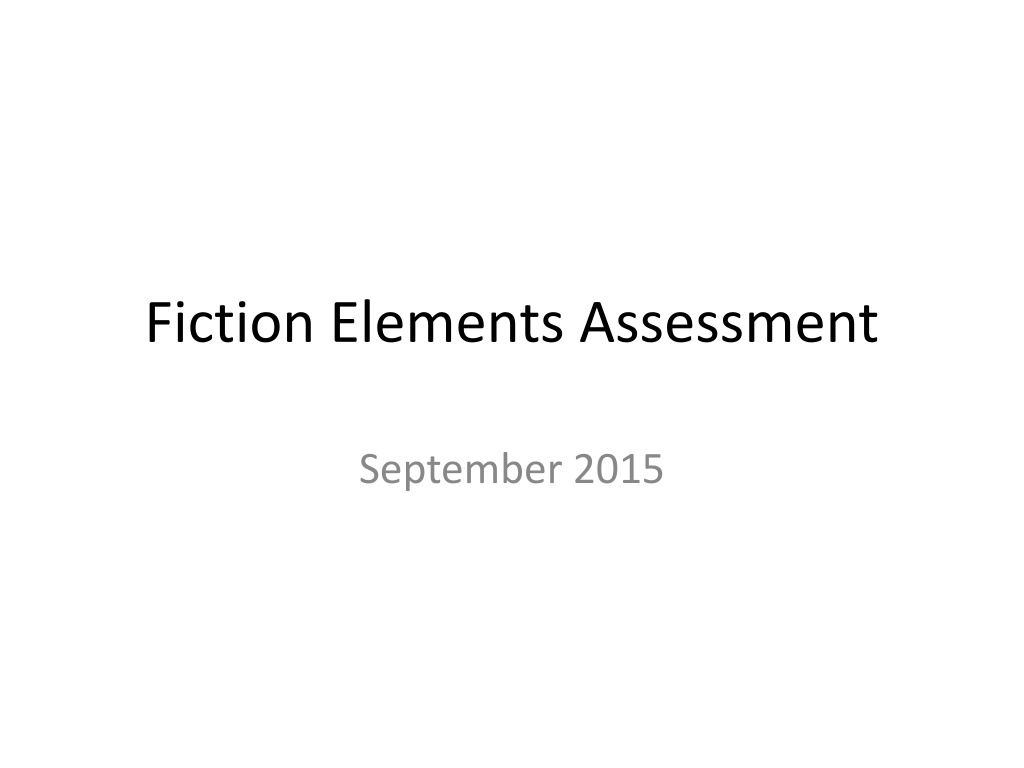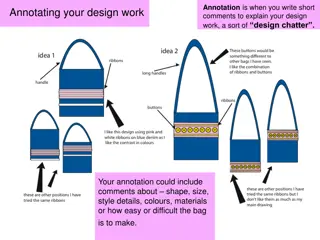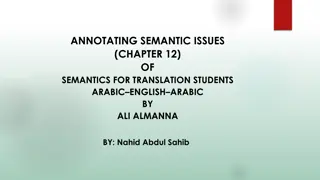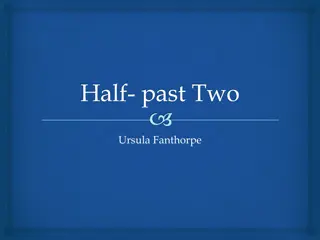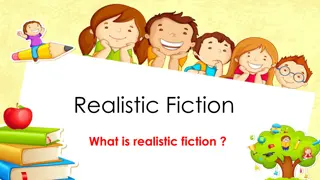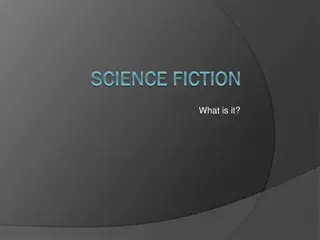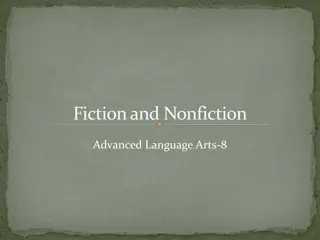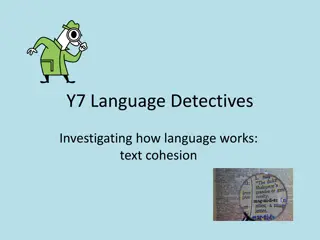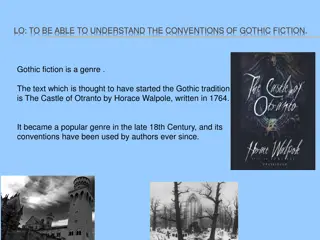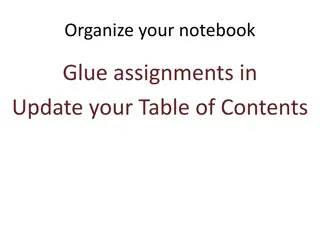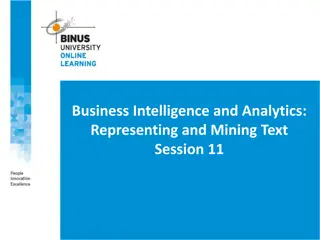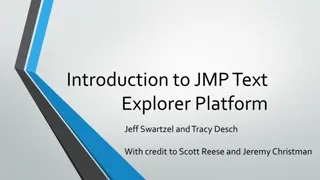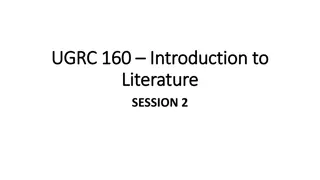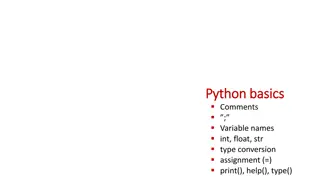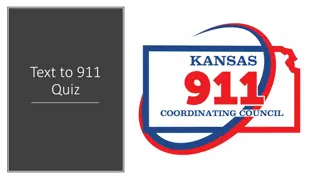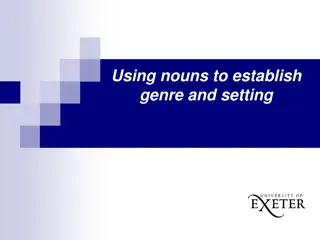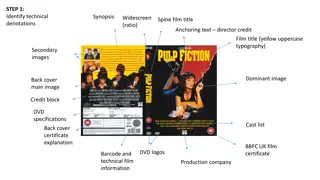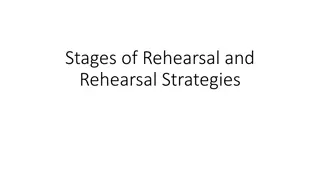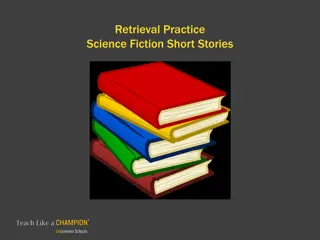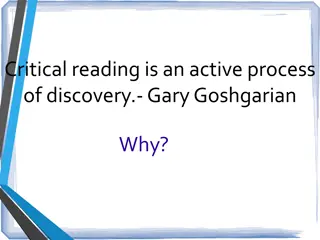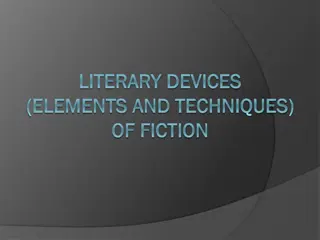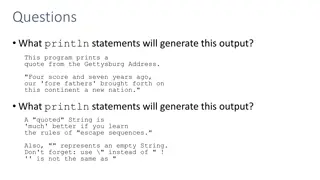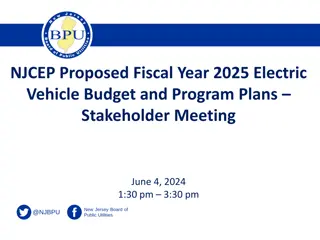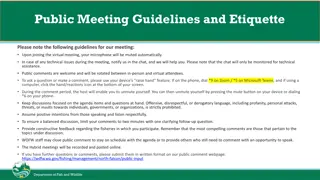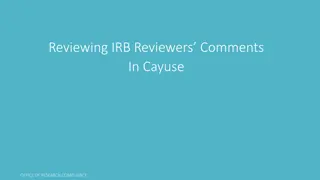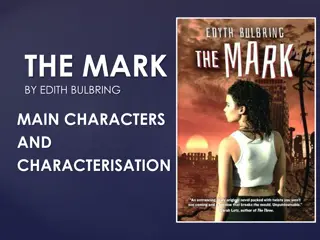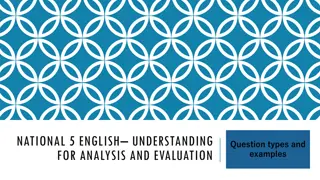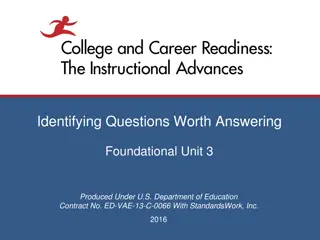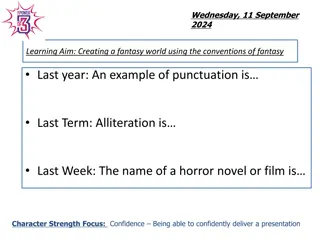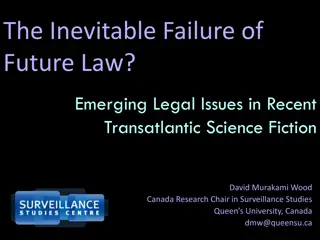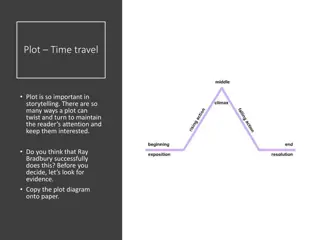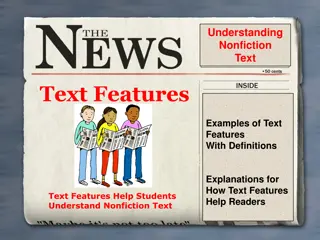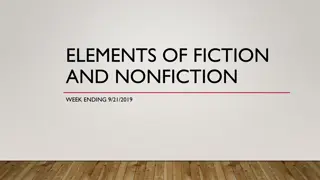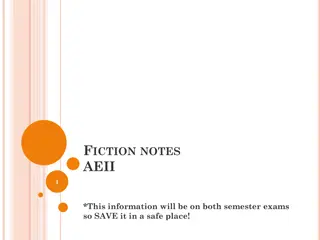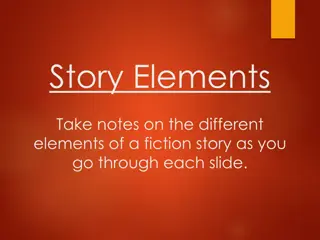Annotating Fiction Elements: How To Effectively Mark Text and Add Comments
Learn how to annotate fiction elements with this step-by-step guide. Discover how to highlight text, change text colors, add comments, and insert text boxes for notes. Enhance your reading comprehension and analysis skills by mastering the art of annotating literary works.
Download Presentation

Please find below an Image/Link to download the presentation.
The content on the website is provided AS IS for your information and personal use only. It may not be sold, licensed, or shared on other websites without obtaining consent from the author. Download presentation by click this link. If you encounter any issues during the download, it is possible that the publisher has removed the file from their server.
E N D
Presentation Transcript
Fiction Elements Assessment September 2015
How to Annotate Highlighting Text Left-click to select the text box Left-click and hold to select the text you would like to highlight Once text is selected, select the Font Color icon to change the color of the text.
How to Annotate Adding Comments Select the Insert tab at the top Choose Insert Text Box Choose the Simple Text Box Place the text box alongside the text where you would like to make your notes Now type! You may change the size of the text box after you finish typing. See the example on the next slide.
How to Annotate Insert Tab Insert Text Box
Fiction Elements and Theme Assessment Read the following passage and answer the questions that follow. A Blind Man Catches a Bird by Alexander McCall Smith eager to get to know his new brother-in-law and so asked him if he would like to go hunting with him. I cannot see, the blind man said. But you can help me see when we are out hunting together. Wee can go. The young man led the blind man off into the bush. At first they followed a path that he knew and it was easy for the blind man to tag on behind the other. After a while, though, they went off into the thicker bush, where the trees grew closely together and there were many places for animals to hide. The blind man now held on to the arm of his sighted brother-in-law and told him many things about the sounds that they heard around them. Because he had no sight, he had a great ability to interpret the noises made by animals in the bush. There are warthogs around, he would say, I can hear their noises over there. Or: That bird is preparing to fly. Listen to the sound of its wings unfolding. To the brother-in-law, these sounds were meaningless, and he was most impressed at the blind man s ability to understand the bush although it must have been for him one great darkness. A young man married a woman whose brother was blind. The young man was
Fiction Elements and Theme Assessment Read the following passage and answer the questions that follow. They walked on for several hours, until they reached a place where they could set their traps. The blind man followed the other s advice, and put his trap in a place where birds might come for water. The other man put his trap a short distance, away, taking care to disguise it so that no bird would know that it was there. He did not bother to disguise the blind man s trap, as it was hot and he was eager to get home to his new wife. They blind man thought that he had disguised his trap, but he did not see that he failed to do so and any bird could tell there was a trap there. They returned to their hunting place the next day. The blind man was excited at the prospect of having caught something, and the young man had to tell him to keep quiet, or he would scare all of the animals away. Even before they reached the traps, the blind man was able to tell that they had caught something. I can hear birds, he said. There are birds in the traps. When he reached his trap, the young man saw that the had caught a small bird. He took it out of the trap and put it in a pouch that he had brought with him. Then the two of them walked towards the blind man s trap. There is a bird in it, he said to the blind man. You have caught a bird too.
Fiction Elements and Theme Assessment Read the following passage and answer the questions that follow. As he spoke, he felt himself filling with jealously. The blind man s bird was marvelously colored, as if it had flown through a rainbow and been stained by the colors. The feathers from a bird such as that would make a find present for his new wife, but the blind man had a wife too, and she would also want the feathers. The young man bent down and took the blind man s bird from the trap. Then quickly substituting his own bird, he passed it to the blind man and put the colored bird into his own pouch. Here is your bird, he said to the blind man. You may put it in your pouch. The blind man reached out for the bird and took it. He felt it for a moment, his fingers passing over the wings and the breast. Then, without saying anything, he put the bird into his pouch and began the trip home. On their way home, the two men stopped to rest under a broad tree. As they sat there, they talked about many things. The young man was impressed with the wisdom of the blind man, who knew a great deal although he could see nothing at all. Why do people fight with one another? he asked the blind man. It was a question which had always troubled him and he wondered if the blind man could give him an answer.
Fiction Elements and Theme Assessment Read the following passage and answer the questions that follow. The blind man said nothing for a few moments, but it was clear to the young man that he was thinking. Then the blind man raised his head, and it seemed to the young man as if the unseeing eyes were staring straight right into his soul. Quietly he gave his answer. Men fight because they do to each other what you have just done to me. The words shocked the young man and made him ashamed. He tried to think of a response, but none came. Rising to his feet, he fetched his pouch, took out the brightly colored bird and gave it back to this blind man. The blind man took the bird, felt it over with his fingers, and smiled. Do you have any other questions for me? he asked. Yes, said the young man. How do men become friends after they have fought? The blind man smiled again. They do what you have just done, he said. That s how they become friends again.
Fiction Elements and Theme Assessment Use A Blind Man Catches a Bird to answer the questions that follow. 1. The overall theme of the story is (8.3B) A. cheat others because it makes them feel smart B. people should rely more on their hearing than on their sight C. true friendship depends on respect and fairness D. hunting is a good way to learn about animal behavior 2. Which sentence below proves that this story is written in the 3rd person limited/subjective point of view? A. The young man led the blind man off into the bush. B. They walked on for several hours, until they reached a place where they could set their traps. C. As he spoke, he felt himself filling with jealousy. D. Why do people fight with one another? he asked the blind man. (8.6C)
Fiction Elements and Theme Assessment Use A Blind Man Catches a Bird to answer the questions that follow. 3. A. does not help the blind man disguise his bird trap B. is impressed that the blind man can understand animal s sounds C. steals the colorful bird so that she can have the feathers D. asks his brother-in-law why people fight You can conclude that the young man is eager to please his new wife when he (Fig 19D, 8.6B) 4. Which sentence below indicates the conflict of this story? A. After a while, though, they went off into thicker bush, where the trees grew closely together and there were many places for animals to hide. B. When he reached his trap, the young man saw that he had caught a small bird. C. Then quickly substituting his own bird, he passed it to the blind man and put the colored bird into his own pouch. D. On their way home, the two men stopped to rest under a broad tree. (8.6A)
Fiction Elements and Theme Assessment Use A Blind Man Catches a Bird to answer the questions that follow. 5. What was the author s primary purpose in writing this selection? A. To describe the relationship between the blind man and the young man B. To teach the lesson that deception is wrong C. To show that the young always disrespect their elders D. To convince people not to take advantage of the blind (Fig 19A)
Fiction Elements and Theme Assessment Use A Blind Man Catches a Bird to answer the questions that follow. 6. Which answer below represents the best summary of the story? A. A young man takes his brother-in-law hunting in the woods. The brother-in-law is able to identify different sounds in the woods, such as warthogs and birds. Because the brother- in-law is blind, the young man is impressed with his ability to interpret sounds and thinks the blind man must be very wise. On the walk home, the young man asks the blind man why people fight and how people become friends again. (Fig 19E) B. Two brothers-in-law go hunting together. The young man leads the hunt because the older brother-in-law is blind. The two men identify an ideal location to set their traps. As the young man sets up the traps, he does not make the effort to disguise the blind man s trap; he is hot and tired and believes that the blind man will not know the difference. When the two men return the next day, the blind man s trap has caught a more beautiful bird than the young man s trap. The young man switches the two birds, taking the more beautiful bird for himself. C. To get to know him better, a young man takes his brother-in-law hunting. When the two men return the following day, the young man is jealous because the blind man s trap has a more beautiful bird than his own. Believing the blind man will not know the difference, the young man switches the two birds. On the way home, the two men discuss human nature. He realizes that the blind man is aware of his actions, so the young man feels ashamed. He returns the more beautiful bird back to the blind man. As the two men continue to talk, the blind man forgives the young man.
Fiction Elements and Theme Assessment Read the following passage and answer the questions that follow. The Birds, the Beast, and the Bat adapted from a fable by Aesop Long ago, the birds were at war with the beasts. Through the years, the power shifted. Sometimes the birds won http://ts2.mm.bing.net/th?id=H.4847799432643057w=223h=188c=7rs=1url=http%3a%2f%2fwww.earthlyissues.com%2fbats.htmpid=1.7 the battle, and sometimes the beasts won. The bat, never knowing how a battle might end, always fought on the side he felt was the strongest. Finally, peace was made, and the birds and the beasts became friends. The bat s dishonest conduct became apparent to both sides. The birds and the beasts decided to punish the disloyal bat and drove him away. From that day, the bat has hidden himself in dark places and is friends with neither birds nor beasts.
Fiction Elements and Theme Assessment Use The Birds, the Beasts, and the Bat to answer the questions that follow. 7. Which character trait BEST suggests the theme of the passage? A. the bat s love of dark places B. the birds and beasts friendship C. the birds and beasts anger D. the bat s disloyalty (8.6B) 8. What is the resolution of this fable? A. The beasts and the birds become friends. B. The bat finally chooses a side. C. The beasts and the birds have a battle. D. The bat is punished for not choosing a side. (8.6A)
Fiction Elements and Theme Assessment Use The Birds, the Beasts, and the Bat to answer the questions that follow. 9. What would the reader learn if this fable was written from the bat s point of view? A. An understanding of how the birds feel about the bat B. An understanding of how the bat feels about being punished C. An understanding of how the beasts feel about the bat D. An understanding of how the birds and the beasts feel about each other (8.6C)
Fiction Elements and Theme Assessment Use both passages to answer the questions that follow. 10. Which answer choice below best completes the Venn Diagram? (8.3B) A. The bat learns his lesson. B. The bat is a lonely creature. C. Both stories are fables. D. The young man learns his lesson.
Fiction Elements and Theme Assessment Use both passages to answer the questions that follow. 11. In comparing these two selections, what was similar in the moral lessons? A. Being responsible for your actions can bring you great success. B. Building friendships can give others happiness. C. Keeping promises will bring you respect. D. Being honest and loyal can bring you better consequences. (8.3A)
Fiction Elements and Theme Assessment Academic Vocabulary: Matching. 12. conflict A. The reader is told what the characters are thinking and feeling 13. protagonist B. The narrator gives only the facts about the events of the story; the reader has to judge a character s thoughts and feelings by what they say and do 14. subjective point of view C. The central character; the most important character in a literary work 15. objective point of view D. The opposition of persons or forces that brings about dramatic action central o the plot of a story
